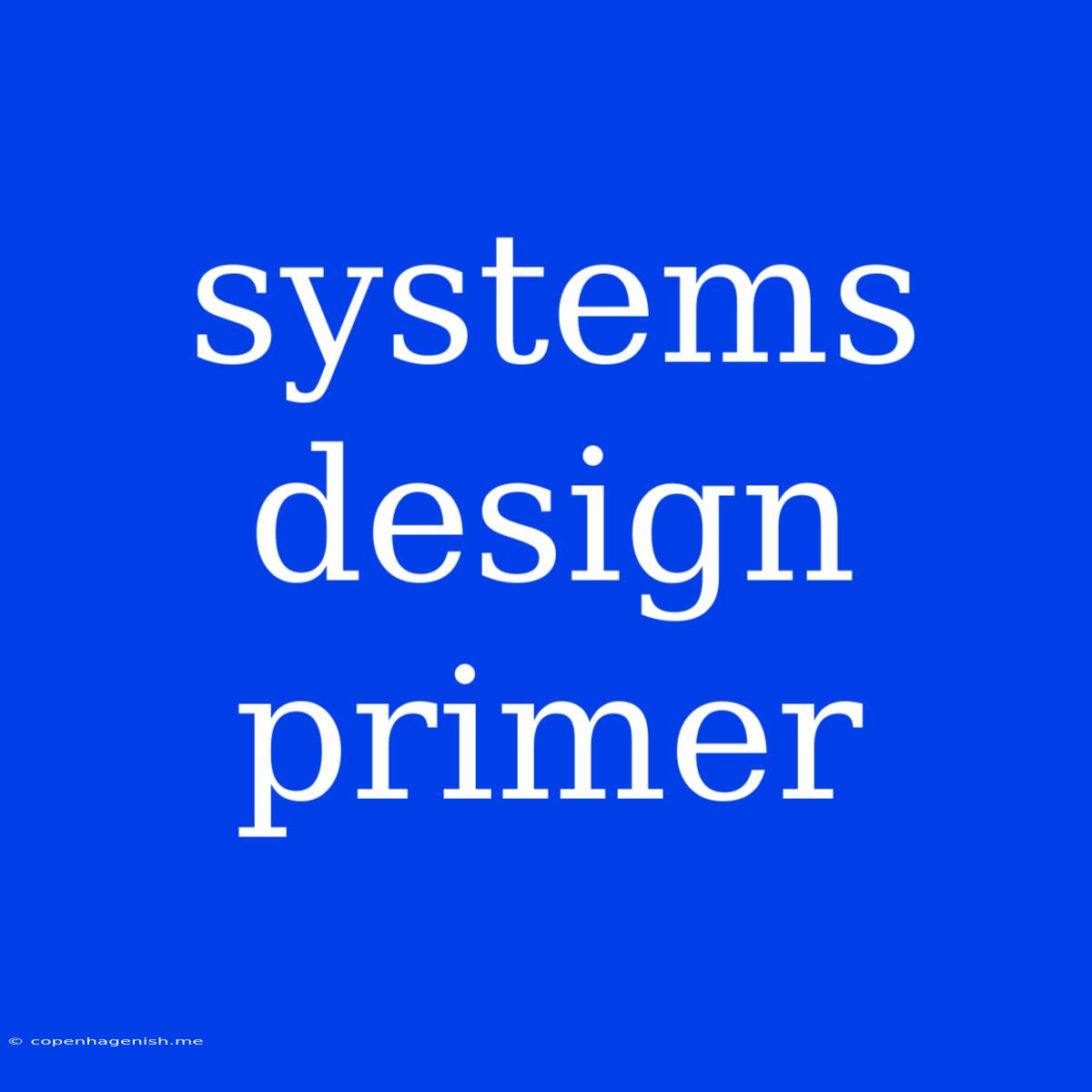Unlocking the Secrets of Systems Design: A Comprehensive Primer for Beginners
Have you ever wondered how massive applications like Google Maps or Facebook operate seamlessly, handling millions of requests every second? This intricate dance of software, hardware, and infrastructure is the realm of systems design. Systems design is the art and science of creating scalable, reliable, and performant systems. This primer will demystify the key concepts, offering a roadmap for understanding the complexities of building robust systems.
Editor Note: This systems design primer is a crucial read for anyone aspiring to build high-performance applications or seeking to advance their understanding of software development at scale. We'll explore the key aspects of systems design, demystifying essential concepts and providing practical insights for building better systems.
Analysis: We conducted a thorough analysis of industry best practices, common design patterns, and popular tools to create a comprehensive guide for beginners. We've simplified complex concepts, providing illustrative examples and analogies to make understanding easier.
Key Takeaways:
| Aspect | Description |
|---|---|
| Scalability | The ability of a system to handle increasing workloads without compromising performance. |
| Availability | The uptime of a system, ensuring it remains accessible to users even during failures. |
| Consistency | Guaranteeing data integrity across multiple requests and ensuring data accuracy. |
| Security | Protecting the system from unauthorized access, malicious attacks, and data breaches. |
| Cost-Effectiveness | Optimizing resource utilization and minimizing operational costs. |
| Maintainability | Designing systems for ease of deployment, updates, and troubleshooting. |
Systems Design Fundamentals
Understanding the Building Blocks:
- Microservices: Breaking down complex applications into smaller, independent services for improved scalability and maintainability.
- Load Balancing: Distributing incoming traffic across multiple servers to prevent overload and ensure even resource utilization.
- Caching: Storing frequently accessed data in a faster, temporary storage to reduce database load and improve response times.
- Databases: Choosing the right database technology (relational, NoSQL, or hybrid) based on data structure and application requirements.
- Networking: Understanding network protocols and infrastructure to ensure seamless communication between different components.
Key Aspects of Systems Design
Scalability:
- Vertical Scaling: Increasing the resources of a single server to handle more load.
- Horizontal Scaling: Adding more servers to distribute the workload and improve performance.
Availability:
- Redundancy: Implementing backup systems and replicating data to minimize downtime in case of failures.
- Fault Tolerance: Designing systems to handle failures gracefully without impacting user experience.
Consistency:
- CAP Theorem: Understanding the trade-offs between consistency, availability, and partition tolerance.
- Data Replication: Maintaining multiple copies of data to ensure consistency and availability.
Security:
- Authentication and Authorization: Ensuring only authorized users have access to sensitive data.
- Encryption: Protecting data in transit and at rest from unauthorized access.
Cost-Effectiveness:
- Resource Optimization: Utilizing resources efficiently to reduce costs and improve performance.
- Cloud-Based Solutions: Leveraging cloud infrastructure for scalability, flexibility, and cost savings.
Maintainability:
- Monitoring and Logging: Implementing tools to track system performance, identify issues, and analyze user behavior.
- Testing and Deployment: Establishing automated testing and deployment processes to ensure quality and reduce errors.
Conclusion:
Understanding systems design principles is essential for building robust and scalable applications. This primer has provided a solid foundation for navigating the complexities of systems design, highlighting key concepts and practical considerations. By applying these insights and continuing to explore best practices, you can confidently design and build efficient, reliable, and secure systems.
FAQ
Q: What are some of the popular tools used for systems design?
A: Tools like AWS, Azure, Google Cloud, and Kubernetes are widely used for building and managing complex systems.
Q: How do I get started with systems design?
A: Start by understanding the fundamentals of software architecture, network protocols, and database technologies. Practice with simple projects and gradually increase the complexity as you gain experience.
Q: What are the challenges associated with systems design?
A: Challenges include balancing performance, scalability, security, and cost-effectiveness, while ensuring maintainability and addressing evolving user needs.
Tips for Successful Systems Design
- Start with a clear understanding of the application's requirements and user needs.
- Break down complex problems into smaller, manageable components.
- Use design patterns and best practices to guide your decisions.
- Continuously monitor and optimize system performance.
- Collaborate with other developers and share knowledge.
Summary of Systems Design Primer
This primer has provided a comprehensive overview of systems design, covering fundamental concepts, key aspects, and practical tips. We've emphasized the importance of scalability, availability, consistency, security, cost-effectiveness, and maintainability. By understanding these principles and applying them in your projects, you can create robust, reliable, and highly functional systems.
Closing Message:
Systems design is a dynamic field, constantly evolving with new technologies and approaches. By staying curious, exploring emerging trends, and embracing continuous learning, you can effectively navigate the challenges of building and managing complex systems in the ever-changing landscape of software development.

